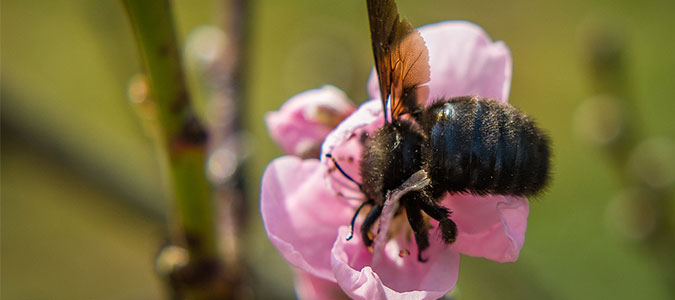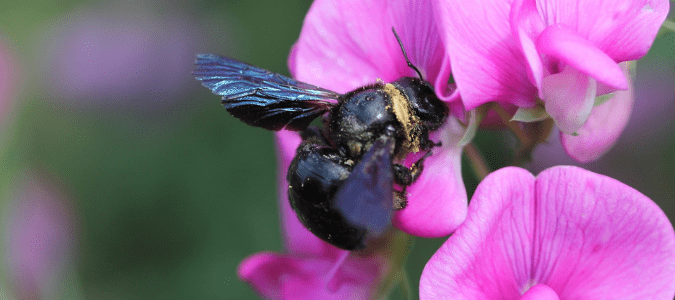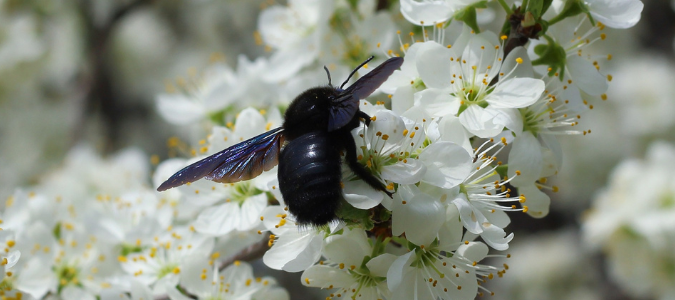Bumblebee Nests
Bumblebee Behavior
Carpenter Bees
These bees look like bumblebees, large in size with yellow and black coloring, and the two are often confused. Carpenter bees can be identified by their solid, shiny black tail section.
Carpenter bees also differ from bumblebees in the way they live. Honey bees and bumblebees live together in colonies, but adult carpenter bees spend winters in their own tunnels. Those that survive the winter emerge in spring. Fertilized female carpenter bees bore into wood and make another tunnel where they lay the eggs.
The entrance to these holes are round and about as big around as a person’s little finger. If you see holes like this in wood around your home, you likely have carpenter bees. To know for sure, call in a licensed professional for an inspection and pest control plan.
How Do You Get Rid of Carpenter Bees?
Deterring Carpenter Bees
Carpenter bees do not typically attack hardwoods, so using this wood for your home’s siding and trim, or planting them in your yard, will help discourage the bees from setting up their own home there. If you have any depressions or cracks in wood surfaces on your home or other buildings, fill them in to make it less likely that the bees will settle in. Make sure to paint or varnish exposed wood surfaces. This reduces weathering, which in turn reduces the chances that bees will attack.
If you see holes that indicate these bees have already moved in, wait until they emerge and then fill them in with steel wool and caulk. That will keep carpenter bees from returning to use the tunnels again. Taking these steps will usually help deter bees without having to resort to insecticides that will harm the bees.
Sometimes you will have a heavy infestation and need help with carpenter bees. In these cases, insecticides might be needed to go along with the preventative measures listed above. In such cases, it is best to treat the existing tunnels where adult bees live early in the spring. Don’t try using insecticides during late spring and summer because the bees seal the tunnels. Once the pesticide has worn off, the bees will just chew their way out. A licensed pest control professional can give you the best estimate of a timetable for when to treat these pests.
Do Carpenter Bees Sting?
Carpenter bees can seem intimidating, especially the males that swarm around people who come near nesting sites. This variety of bees isn’t as likely to sting you as other bees that live in groups. In any case, male carpenter bees won’t hurt you since the male bees cannot sting.
Female carpenter bees, however, can definitely sting, and it can be painful. The good news is that they aren’t generally aggressive and only sting when people bother them or try to handle them. Carpenter bees are able to sting more than once, and if you or a loved one is stung multiple times, it is best to seek medical attention.
For most people, a single sting from a carpenter bee will hurt and likely swell, but it won’t need professional help. After a sting, check to see if the stinger is still in the skin. If it is, take a fingernail and scrape it along the skin to get it out. If you leave it in, more venom will release and the sting will hurt even more. Once the stinger is gone, you can clean the area with soap and water but then leave that area of your skin to dry. Fresh air helps with healing. For swelling, try an ice pack.
Some people are allergic to bee stings, and for those folks, it is important to get medical help immediately. Many people with such life-threatening allergies carry emergency medication to help reduce the reaction as well.
The best way to prevent a carpenter bee’s sting is to stay away from them. If you notice an increasing number of these bees hovering around your home or yard or see the telltale signs that the bees are moving into your trees and siding, call in the experts. A licensed pest control professional will thoroughly inspect all suspected nesting areas and formulate a plan to remove carpenter bees and keep your family safe.
ABC Can Get Rid of Your Bee Issues
Seeing bees on your property can be frightening. Instead of trying to handle the bee problem on your own, contact ABC Home & Commercial Services. Our pest control professionals can effectively remove these pests, so you don’t have to worry about painful stings.


